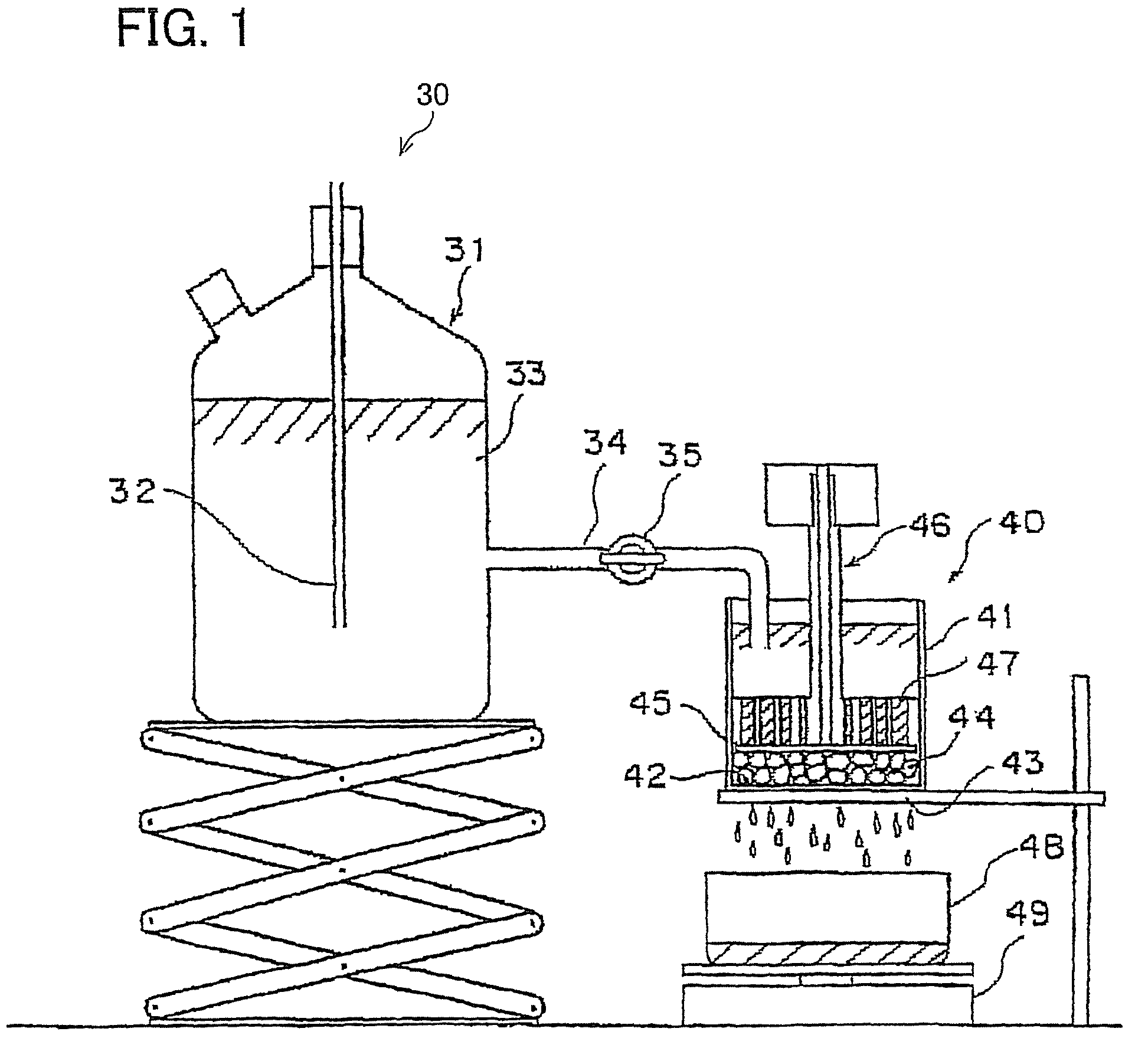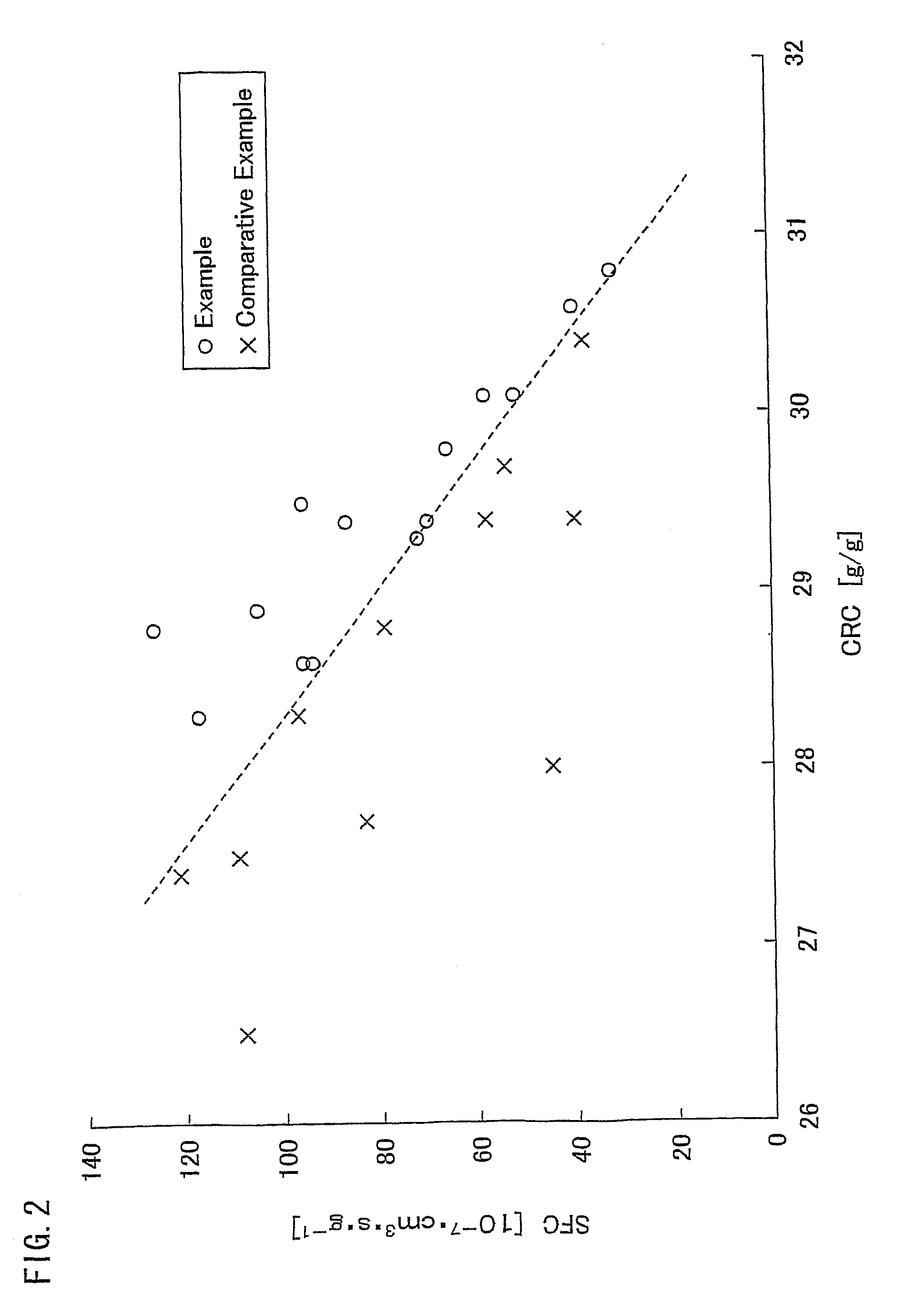Water absorbing resin with improved internal structure and manufacturing method therefor
a technology of internal structure and water absorbing resin, which is applied in the direction of cellulosic plastic layered products, natural mineral layered products, bandages, etc., can solve the problems of insufficient value of water absorbing resin with these physical properties, difficult to achieve good values with both physical properties, and insufficient conventional technology. achieve excellent centrifuge retention capacity, improve internal structure, and improve the effect of saline flow conductivity
- Summary
- Abstract
- Description
- Claims
- Application Information
AI Technical Summary
Benefits of technology
Problems solved by technology
Method used
Image
Examples
example 1
[0236]436.4 g of an acrylic acid, 4617.9 g of a 37 mass % aqueous solution of sodium acrylate, 373.8 g of pure water, and 11.40 g of polyethylene glycol diacrylate (weight-average molecular weight Mw 523) were dissolved in a reactor which was a lidded double-arm stainless steel kneader (internal volume 10 liters) equipped with two sigma-type blades and a jacket, to prepare a reaction solution. Next, the reaction solution was deaerated in a nitrogen gas atmosphere for 20 minutes. Subsequently, 36.33 g of a 10 mass % aqueous solution of sodium persulfate and 24.22 g of a 0.1 mass % aqueous solution of L-ascorbic acid were added to the reaction solution while stirring, about 25 seconds after which polymerization started. The polymerization was let to proceed at 25° C. to 95° C. inclusive, while crushing the produced gel. The water-containing gel-like crosslinked polymer was removed 30 minutes into the polymerization. After the polymerization started, it took not longer than 15 minutes ...
example 2
[0242]436.4 g of an acrylic acid, 4617.9 g of a 37 mass % aqueous solution of sodium acrylate, 377.5 g of pure water, and 10.13 g of polyethylene glycol diacrylate (weight-average molecular weight Mw 523) were dissolved in a reactor which was a lidded double-arm stainless steel kneader (internal volume 10 liters) equipped with two sigma-type blades and a jacket, to prepare a reaction solution. Next, the reaction solution was deaerated in a nitrogen gas atmosphere for 20 minutes. Subsequently, 33.91 g of a 10 mass % aqueous solution of sodium persulfate and 24.22 g of a 0.1 mass % aqueous solution of L-ascorbic acid were added to the reaction solution while stirring, about 25 seconds after which polymerization started. The polymerization was let to proceed at 25° C. to 95° C. inclusive, while crushing the produced gel. The water-containing gel-like crosslinked polymer was removed 30 minutes into the polymerization. After the polymerization started, it took not longer than 15 minutes ...
example 3
[0248]436.4 g of an acrylic acid, 4617.9 g of a 37 mass % aqueous solution of sodium acrylate, 372.6 g of pure water, and 10.13 g of polyethylene glycol diacrylate (weight-average molecular weight Mw 523) were dissolved in a reactor which was a lidded double-arm stainless steel kneader (internal volume 10 liters) equipped with two sigma-type blades and a jacket, to prepare a reaction solution. Next, the reaction solution was deaerated in a nitrogen gas atmosphere for 20 minutes. Subsequently, 38.76 g of a 10 mass % aqueous solution of sodium persulfate and 24.22 g of a 0.1 mass % aqueous solution of L-ascorbic acid were added to the reaction solution while stirring, about 25 seconds after which polymerization started. The polymerization was let to proceed at 25° C. to 95° C. inclusive, while crushing the produced gel. The water-containing gel-like crosslinked polymer was removed 30 minutes into the polymerization. After the polymerization started, it took not longer than 15 minutes ...
PUM
| Property | Measurement | Unit |
|---|---|---|
| weight-average molecular weight Mw | aaaaa | aaaaa |
| weight-average molecular weight Mw | aaaaa | aaaaa |
| mass-average particle diameter D50 | aaaaa | aaaaa |
Abstract
Description
Claims
Application Information
 Login to View More
Login to View More - R&D
- Intellectual Property
- Life Sciences
- Materials
- Tech Scout
- Unparalleled Data Quality
- Higher Quality Content
- 60% Fewer Hallucinations
Browse by: Latest US Patents, China's latest patents, Technical Efficacy Thesaurus, Application Domain, Technology Topic, Popular Technical Reports.
© 2025 PatSnap. All rights reserved.Legal|Privacy policy|Modern Slavery Act Transparency Statement|Sitemap|About US| Contact US: help@patsnap.com



